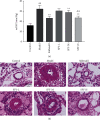Shufeiya Recipe Improves Monocrotaline-Induced Pulmonary Hypertension in Rats by Regulating SIRT3/FOXO3a and Its Downstream Signaling Pathways
- PMID: 35222742
- PMCID: PMC8881168
- DOI: 10.1155/2022/3229888
Shufeiya Recipe Improves Monocrotaline-Induced Pulmonary Hypertension in Rats by Regulating SIRT3/FOXO3a and Its Downstream Signaling Pathways
Abstract
Pulmonary hypertension (PH) is a chronic and progressive disease caused by obstructions and functional changes of small pulmonary arteries. Current treatment options of PH are costly with patients needing long-term taking medicine. The traditional Chinese medicine (TCM) compound "Shufeiya Recipe" was used to intervene in monocrotaline- (MCT-) induced pulmonary hypertension in rats. The rats were randomly divided into the control group, model group, positive drug (Sildenafil) group, and Shufeiya Recipe low-, moderate-, and high-dose groups. The improvement effect of the Shufeiya Recipe on the mean pulmonary artery pressure (mPAP) was assessed in PH rats, and pathological staining was used to observe the pathological changes of lung tissue. The impact of the Shufeiya Recipe on oxidative stress damage in rats with pulmonary hypertension and the regulation of SIRT3/FOXO3a and its downstream signaling pathways were determined. The results showed that Shufeiya Recipe could significantly downregulate mPAP and improve lung histopathological changes; downregulate serum levels of reactive oxygen species (ROS); upregulate the concentrations of COX-1 and COX-2 and the activity of Mn-SOD; inhibit oxidative response damage; promote the protein expression of SIRT3, FOXO3a, p-PI3K, p-AKT, and p-eNOS; increase the level of expression of NO, sGC, cGMP, and PKG; and downregulate the level of protein expression of Ras, p-MEK1/2, p-ERK1/2 and c-fos. These results indicate that Shufeiya Recipe can improve MCT-induced pulmonary hypertension in rats by regulating SIRT3/FOXO3a and its downstream PI3K/AKT/eNOS and Ras/ERK signaling pathways.
Copyright © 2022 Zhuangzhuang Jia et al.
Conflict of interest statement
The authors declared no conflict of interest regarding this article.
Figures







References
-
- Zhang J., Dong J., Martin M., et al. AMP-activated protein kinase phosphorylation of angiotensin-converting enzyme 2 in endothelium mitigates pulmonary hypertension. American Journal of Respiratory and Critical Care Medicine . 2018;198(4):509–520. doi: 10.1164/rccm.201712-2570OC. - DOI - PMC - PubMed
MeSH terms
Substances
LinkOut - more resources
Full Text Sources
Medical
Research Materials
Miscellaneous

